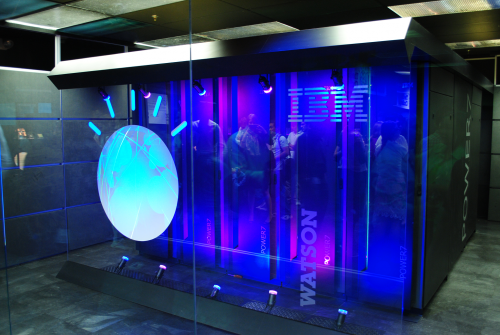
This computer isn’t connected to the internet. It takes up an entire room, and its made by IBM. This sounds like the kind of technology you would find in a 1980 edition of Compute! Magazine. Instead, Engadget has been following the story in the traditional 21st century manner of tech news coverage: live blogging with photos and under-10-minute video interviews. The new computer making news is Watson [official IBM website for the Watson project], a new 80 teraflop supercomputer meant to answer natural language questions. It was demoed last Thursday at IBM’s research facility in Armonk, NY. Watson is being tested in the most grueling tournament of fact retrieval know to humankind: it is competing in several games of Jeopardy! against reigning champions Ken Jennings and Brad Rutter.
IBM intends to commercialize the technology by selling it to large medical and data industries who need to provide lots of seemingly routine answers to questions from a wide array of topics. By developing a system that can understand the subtlety of human language -with all of its puns, idiomatic expressions, and contextual meaning- data becomes retrievable in a very human way.
Consider Clippit (more commonly refereed to as “Clippy”), the smug, ineffectual, anthropomorphized paper clip form Microsoft Word circa 1998. The bane of most office workers’ existence, this “office assistant” would monitor your work and try to help you with writing a letter or printing some labels. CNET ranked Clippy (and Microsoft Bob) as the worst product of the decade, and has since been totally removed from all Microsoft products since 2007 but still remains the “Edsel” of the computer industry.
Clippit was a failure largely because it was so bad at figuring out what you wanted. The interface was meant to be welcoming and “natural” but was more like a broken record player stuck on a song you didn’t want to hear. Watson isn’t an enormous supercomputer (it wouldn’t even rank on the Top500 list), but it is still several years away from individual commercial use. While we wait for Moore’s law to do its job we can contemplate the implications for natural language inputs. IBM engineers tout Watson as the first step towards the computers on Star Trek: massive (and invisible) computers that are able to understand virtually any natural language command.
In reality, this machine could be your next doctor. Describe your symptoms, swab your mouth, and wait for Dr. Watson to come back with the test results. It could be the penultimate customer service representative: a worthy opponent in your battle to speak with a real level two service technician. As a twenty-something, I look forward to complaining about how no one works for the answers to their questions. “In my day, we Google searched our aches and pains until we found a WebMD article that vaguely sounded like what we had, and we were happy!”

Comments 1
Watson Reminds us of our Relationship to Computers (Part 1) | David A Banks — March 6, 2014
[…] providing continuing coverage of IBM’s Watson computer over at Cyborgology. Will this massive feat in computational might be used for good, or evil? […]